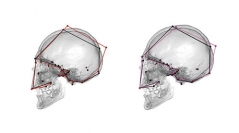

 Comptes Rendus Palevol
16 (5-6) - Pages 545-556
Comptes Rendus Palevol
16 (5-6) - Pages 545-556Artificial cranial deformations (ACD) are a widespread cultural practice found in numerous historical and prehistoric contexts. Their study can yield valuable insight into craniofacial growth, specifically into the interactions between neurocranial and basicranial modules. This study seeks to reinvestigate the presumed effect of ACD on basicranial and masticatory elements by applying a 3D geometric morphometric approach to CT scans. A total of 51 French and Bolivian skulls, representing anteroposterior and circumferential deformations and including undeformed individuals, were scanned, and 3D landmarks were submitted to between-group principal components analysis and two-block partial least-squares analysis. Our results illustrate changes in basicranial shape and in cranial base angles induced by ACD, as well as in masticatory geometry, namely in the relative position of the mandibular fossae. Furthermore, our findings highlight differential effects of the various deformation types, which suggest that patterns of covariation between modified vaults and their associated basicrania are more complex than previously assumed, thereby stressing the degree of plasticity in human craniofacial growth.
Artificial cranial deformation, Basicranial flexion, Temporomandibular joint, Covariation, Geometric morphometrics